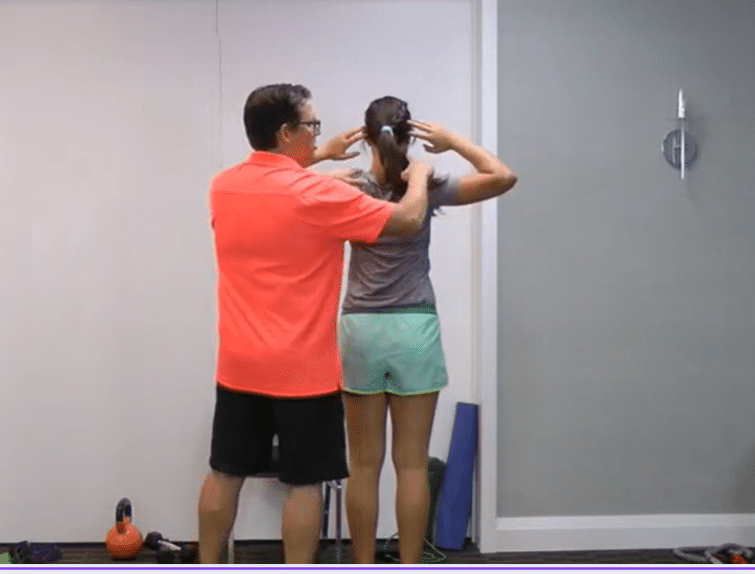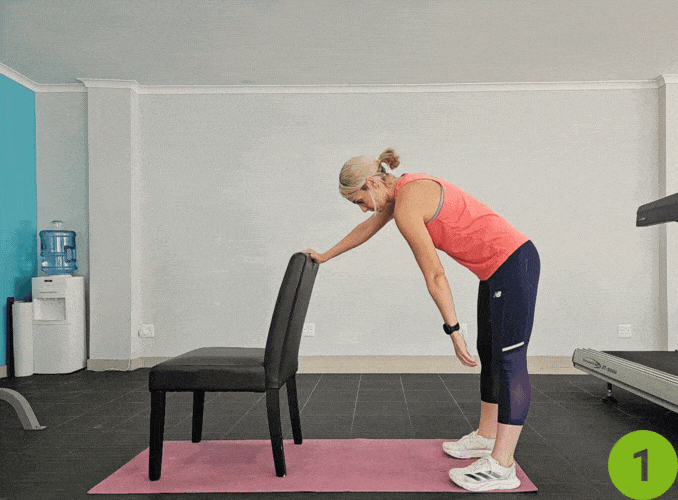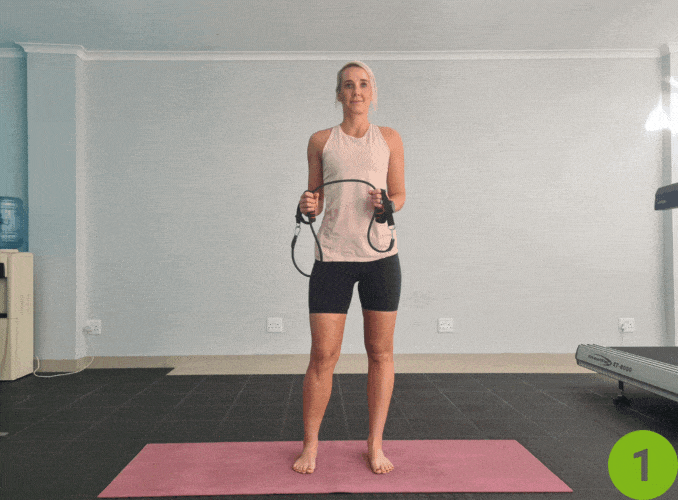Shoulder pain [1] is a common issue that can arise from various causes, including poor posture, overuse, injuries, underlying medical conditions, or a lack of exercises for shoulder pain.
Whether you’re dealing with a frozen shoulder [2], rotator cuff issues, or general muscle soreness, targeted exercises can help improve movement, reduce pain, and prevent further joint problems.
Medical Disclaimer: The information in this blog is for enlightening and educational purposes only and is not intended as medical advice. The content in this post is not meant to substitute for a professional medical diagnosis, advice, or treatment. Always ask advice from your physician or other qualified health providers with any questions you may have regarding a medical condition.
1. Standing Back Arch
- Perform one set of 5 reps in a smooth, controlled movement with a good stop at the end position for 1 to 2 seconds.
- And we are looking for a light stretch in the shoulder.
- And then light mobility and movement happening in the spine.
In standing position, but the hands on the hips get a good stretch in the shoulders and arch the back to improve mobility when it comes to the low back and mid-back areas.
In this exercise, we are improving the mobility in the whole spine to help relieve back pain | 404. We are also improving the shoulder’s mobility and flexibility to help ease shoulder pain.
2. Downward Punch Exercise
- Do a downward punch.
- In standing position, with a good alignment of the head and shoulders.
- After that, grab the weights.
- And punch down then repeat back and forth.
In this exercise, we are going to use some weights or dumbbells. If you do not have dumbbells, you can go without weights, but weights help a little bit when it comes to guiding the movement.
In this exercise, we are putting the shoulder in a better position when punching down and decreasing the stress in the upper neck area and then mid-back area. This is more of a mobility or posture exercise, decreasing tension in the muscles exercised.
Perform one set of 5 reps in a smooth, controlled movement, holding the bottom position for a stop of 1 to 2 seconds with light intensity.
3. Vertical Hanging Exercise
- Find a door frame, reach up anf then grab the door frame.
- Raise your arms and straight above your shoulders.
- Bend through the knees and drop the hips to increase the stretch that you feel in your shoulders and back area.
This is an excellent exercise to loosen up the muscles in the back and shoulder to relieve pain.
Perform one set of 5 steps, starting with 5 seconds then progress to 15 seconds with an intensity of the light stretch in the shoulders and then back area.
Modified Vertical Hanging Exercise
- Perform one set of 5 steps, starting with 5 seconds.
- Progress to 15 seconds with an intensity of the light stretch in the shoulders.
- And then back area.
4. Full Nelson Elbows Back

- Stay relaxed.
- After that, bring your hands toward your head while your arms are rotated externally.
- Use the muscles in your mid back to bring your elbows back.
Women often have good flexibility in the shoulders but lack activation, endurance, and strength in their midback shoulder areas. The full Nelson elbows back exercise targets the midback shoulder blade muscles. You may feel some activity or small movement in the upper traps.
Perform one set of 5 reps in a smooth, controlled movement, with a good stop at the end for 1 to 2 seconds. You should feel the muscles in your midback and shoulder blade area working. There could be some fatigue as opposed to a burning or a muscle-building feeling through this exercise.
5. Wall Push- Up Plus
- Form a good straight-line ― ankles, knees, hips, shoulders, and head ― with your hands flat against the wall, just below shoulder height.
- Push up against the wall, then the “plus” is performed by protracting the shoulder blades and then rounding the back.
This targets the serratus anterior, a deep muscle in the armpit with poor activation, strength, and then endurance in women.
Perform one set of 5 reps in a smooth, controlled movement, with a good stop at the start and end for 1 second each in this simple exercise. You should feel the muscles in your shoulders and then muscles deep down through your armpits working.
6. Three-way Tubing Exercise
- Use resistance tubing, available at any health, fitness, sporting goods, or big-box stores.
- Hold the tubing shoulder-width apart with a close grip, and then separate your fists.
- Make a 45-degree angle with your body while keeping the tubing straight.
- Move and then repeat this on the other side.
We’re working on the midback area with arms straight through this exercise. Now at an angle with the high arm, you are working on the lower part of the shoulder blade. You are targeting the lower shoulder blade’s middle and lower parts with the lower arm.
Perform one set of 5 reps for each position in a smooth, controlled movement with a good stop at the end. You should feel the muscles in your shoulder blades working as you move your arms from a straight line to an angled position. This may be challenging as we target specific muscles that lack activation, endurance, and then strength.
7. Chair Push-ups
- Sit on a chair and then try these exercises for shoulder pain.
- After that, straighten your arms, bring your shoulder blades down.
- And then slowly bring your seat up off the chair.
This simple exercise targets the lower shoulder blades while relaxing the upper trap muscles, which are usually tight or stiff in most women.
Perform one set of 5 reps in a smooth, controlled movement, with a good stop at the end for 1 to 2 seconds. You should feel the muscles in your shoulder blade, specifically working the lower part.
8. Shoulder Shrug
- In a standing position with feet together or slightly separated.
- After that, shrug the shoulders up to perform exercises for shoulder pain.
- And then roll them back and repeat.
Perform one set of 5 reps in a smooth, controlled movement with a good stop and good contraction between shoulder blades in each of the movements.
This exercise helps break up the tension in the upper trapezius by contracting and relaxing the upper trapezius. It also helps improve the posture and activates the muscles around the shoulder blades and midback area.
9. T- Raises Against the Wall
- Keep your head, midback, and then hips up against the wall.
- Bring your upper arms, elbows, and forearms up against the wall.
- Slide your forearms upward, trying to bring your hands too close together.
Perform one set of 5 reps in a smooth, controlled movement, which is relatively slow with a good stop at the top position for 1 second.
With this starting position, you are getting a stretch in the shoulders. Placing your head, midback, and hips up against the wall helps you with good posture alignment. As you bring the hands closer together, you are stretching throughout the shoulder and working on flexibility and then mobility of the shoulder.
10. Shoulder L’s
- Stand upright with your legs underneath your hips and then your toes pointing straight ahead.
- After that, rotate your shoulders, alternating back and forth with one hand up and then one hand down in an “L” shape.
Perform one set of 5 reps each way in a smooth, controlled movement with a good stop at the end with light intensity. In this exercise, we are working on the flexibility and then mobility of the shoulders.
11. Three-direction Band Pull
- With this exercise, use a resistance band.
- Go through a three-direction band pull exercise for shoulder pain.
- After that, stand tall with your head, shoulders, and then hips all in proper alignment.
- Hold the resistant tubing with your arms slightly below shoulder height.
- Extend your arms out to your sides, then move to a 45-degree angle on one side, then to the other side.
Perform one set of 5 reps of each of the positions in a smooth, controlled movement with a good stop at the end with moderate intensity.
In this exercise, we are targeting the muscles in the midback, rhomboids, and middle fibers of the trapezius. We want to decrease how much activity we have in the upper trapezius while also working on the muscles around the shoulder blades.
12. Vertical Hanging Exercise
- To do this, grab a pull bar and hang from it as part of your exercises for shoulder pain.
- You can also use the top of a door frame to hang from in order to stretch out the shoulders.
- Grab something overhead that can handle your weight, bend through the knees, and stretch as much as you can in the shoulder.
- Start off with one set of 5 repetitions, holding for 5 seconds.
- You can progress to one set of 5 repetitions, holding for 15 seconds.
Vertical Hanging Exercise is the best way to build, strengthen and define your back muscles. This exercise will help you build stronger and more defined shoulders, but also develop the muscle in your lower back.
With the advancement of technology, vertical hanging exercise has been brought to the forefront. Not only does it provide a good balance of cardio and strength training, but it is also low impact on the joints. The best part about this form of exercise is that you can do it anywhere with little effort.
13. Seated Push-Up
- Sit upright near the edge of a chair to perform exercises for shoulder pain.
- Bring your arms to the sides, bring your seat off of the chair, and then lower back down with resistance from your arms.
- Pushing down brings the shoulder blade down and works the serratus anterior muscles.
- Start with one set of 5 repetitions in a smooth controlled movement, and then hold the end position for one or two seconds.
Seated push-ups are a great way to work on your upper body and core strength. These types of push-ups allow you to maintain balance while working the muscles in your arms, chest, back, shoulders, abs, and legs.
By using your hands on a chair or table for stability, these exercises will help you build a stronger core and prevent injury. They also provide an effective way to strengthen your triceps and pectoral muscles.
Seated push-ups require some coordination but are a great move to add to your exercise routine. This is a simple move that can be done anywhere.
14. Downward Punch Exercise
For this exercise, you need to use a small dumbbell.
- Begin in an upright standing position with your feet hip width apart.
- Maintain good alignment with your head, shoulders, hips, and legs.
- Place your hands at your sides with dumbbells on each hand.
- Engage your core muscles and try exercises for shoulder pain.
- Inhale as you straighten your spine, then exhale as you punch your arms upwards and downwards while keeping your shoulders engaged.
- Repeat the movements with 5 repetitions.
15. Pendulum Stretch

- Begin in an upright standing position with your feet shoulder-width apart.
- Maintain good alignment with your head, shoulders, hips, and legs.
- Lean forward and place one hand at the back of the chair while letting it squeeze your shoulder blades and opposite arm hang freely.
- Move back to increase the angle of your body.
- Tighten your abdominal muscles and slowly rotate your arm in small circles.
- Repeat the movement with 5 repetitions.
- Relax and then repeat the movement on the opposite side.
Modification for Frozen Shoulder: Use smaller circles and avoid overextending your arm. If the movement causes pain, start with gentle side-to-side swings instead of full circles.
16. Internal and External Rotation

For this exercise, you need to use resistance tubing.
- Begin in an upright standing position with your feet shoulder-width apart.
- Maintain good alignment with your head, shoulders, hips, and then legs.
- Hold a resistance band with the handles at your sides, ensuring enough space between your hands for proper stretching.
- After that, engage your core muscles.
- Pull one arm outward while keeping the opposite arm and then elbow tight on the side to create resistance to the band.
- Hold the position for a few seconds.
- Pull back inward to return to the starting position and then repeat the movement on the opposite side.
Common Causes of Shoulder Pain
- Rotator Cuff Injuries [3]– Tears or inflammation in the tendons that stabilize the shoulder joint.
- Frozen Shoulder – Stiffness and limited range of motion caused by inflammation and scar tissue.
- Shoulder Impingement – When shoulder muscles rub against bones, leading to pain and inflammation.
- Poor Posture– Slouching can weaken shoulder muscles and cause discomfort.
- Arthritis– Joint problems like osteoarthritis can lead to chronic pain.
- Overuse and Repetitive Movements – Activities that strain the shoulder muscles can result in injuries over time.
Treatment and Management of Shoulder Pain
Shoulder pain may not be a life-threatening medical condition, but without the right approach, the pain may limit your arm movement and affect the quality of your life.
Your shoulder pain may affect your activities of daily living, such as:
- brushing your teeth
- combing your hair
- putting a book on a shelf
- sleeping on that shoulder
- opening doors
- reaching to the side to grab something
- holding your cellular phone
- carrying your purse or laptop bag
Non-invasive or conservative approaches are used to initially treat shoulder pain. During the early stages or uncomplicated cases of shoulder pain, the treatment goals are relief of pain and restoration of the normal function of the shoulder.
These goals can be achieved through rest, ice and heat application, compression, and then pain medications and exercises.
1. Active Rest for Shoulder Pain
Prevent performing activities that aggravate your shoulder pain. If your shoulder is injured or in pain, the most immediate and essential action is to reduce or stopping using the injured arm for about 48 hours.
Avoid heavy lifting and overhead activities until your shoulder feels better, which may take 4 to 7 days after shoulder pain occurs. Resting the affected shoulder can reduce the swelling and then the pain. It is important to emphasize that complications may arise when the shoulder area is immobile for a lengthened period.
Pain-free shoulder movements are essential to keep moving. It is suggested to perform simple isometric exercises during shoulder pain to activate the shoulder muscles. This is discussed in the next section.
2. Ice and Heat for Shoulder Pain
The application of ice reduces the pain and then inflammation during the first 24 to 48 hours following your shoulder injury. You may put an ice pack, a bag of frozen vegetables, or a towel filled with ice on the affected shoulder for 15 to 20 minutes at a time, 4 to 8 times a day.
Apply ice for about 20 minutes. Never apply ice directly to the skin as it may cause a burn. Use a protective barrier, such as a towel, between the ice and the skin.
You can also apply ice after activities to control inflammation and pain. Everyone responds to ice differently.
Try it out and see how your shoulder responds. It should help decrease inflammation, pain, and then recovery from activities or exercise.
Heat can cause vasodilation and may cause more swelling and pain. The use of heat should be avoided for the first 72 hours.
After 72 hours, when the pain and inflammation have improved, you may start heat applications to relax tightened muscle tightness. Heat should be limited to 20 minutes per application.
3. Pain medications for shoulder pain
Nonsteroidal anti-inflammatory drugs, such as aspirin, ibuprofen, or naproxen, may help reduce mild to moderate shoulder pain.
It is essential to talk with your doctor to see what pain medication is most suited to you.
4. Compression of the Shoulder
Compressing the injured area with elastic wrap may be helpful as well. This could help with controlling inflammation, keeping the shoulder out of painful movements, and your body in a more comfortable posture.
Other Remedies for Shoulder Pain
- Ice and Heat Therapy: Ice Therapy: Apply an ice pack wrapped in a cloth to the affected area for 15–20 minutes, every 2–3 hours, especially after activity.
- Heat Therapy: Use a heating pad or warm compress for 15–20 minutes to relax stiff muscles. Avoid using heat immediately after an injury.
- Massage Therapy: Helps release tension in the shoulder muscles.
- Good Posture: Maintain proper alignment to reduce strain.
- Avoid Overuse: Give your shoulders time to rest and recover.
- Strengthening Exercises: Engage in regular exercises to keep shoulder muscles strong and flexible.
How to Prevent Shoulder Pain
- Stretch regularly: Incorporate shoulder and neck stretches into your daily routine.
- Maintain Shoulder Strength: Strengthening exercises help prevent injuries.
- Modify Activities: Avoid repetitive movements that strain the shoulder.
- Use Proper Lifting Techniques: Keep your shoulders stable when carrying heavy objects.
American physical therapist Adam Wittbrodt, owner of Level Up Fitness and Training, emphasizes that strategic exercise can alleviate shoulder pain by strengthening muscles, improving joint stability, and enhancing blood flow. He recommends targeted exercises such as shoulder rolls, neck stretches, and yoga or Pilates to reduce discomfort and improve mobility. Wittbrodt advises starting slowly, focusing on proper form, maintaining consistency, and then incorporating recovery practices to effectively manage shoulder pain.
When to See a Doctor

- Severe or Persistent Pain– If pain does not improve with rest and then exercise.
- Swelling or Deformity – Indicates a possible fracture or serious injury.
- Limited Range of Motion – If your shoulder becomes stiff and difficult to move, try exercises for shoulder pain to improve mobility.
- Pain at Night – Shoulder pain that disrupts sleep may need medical evaluation.
Final Thoughts
Shoulder pain can limit your daily activities, but with the right strengthening and stretching exercises, you can improve mobility and relieve discomfort. If you experience persistent pain, consult a physical therapist to develop a personalized treatment plan. Start incorporating these exercises into your routine to support long-term shoulder health!
If you want to heal, lengthen and strengthen the muscles and tendons near your shoulders, loosen your shoulder joint and reshape your shoulder so that you can reduce and eliminate your shoulder pain and prevent it from occurring again in the future, then check out the Shoulder Pain Solved program, here!
Frequently Asked Questions
Best exercise for shoulder pain?
- Pendulum Swings: Gently move your arm in small circles to improve mobility.
- Shoulder Rolls: Roll your shoulders forward and backward to release tension.
- Wall Slides: Slide your arms up and down a wall to stretch and strengthen shoulder muscles.
How can I relieve shoulder pain quickly?
- Apply an ice pack for 15–20 minutes to reduce inflammation.
- Use a heating pad for stiffness after 48 hours.
- Perform gentle stretches like neck tilts or shoulder shrugs to release tension.
How do I massage shoulder pain at home?
- Use your fingers or a massage ball to apply circular pressure on tight areas.
- Start gently and gradually increase pressure as the muscles relax.
- Focus on areas near the shoulder blade and the back of the neck.
What is the best sleeping position for shoulder pain?
- Sleep on your back with a pillow supporting your shoulders and neck.
- If you sleep on your side, place a pillow between your knees and keep your affected shoulder elevated with a pillow.


